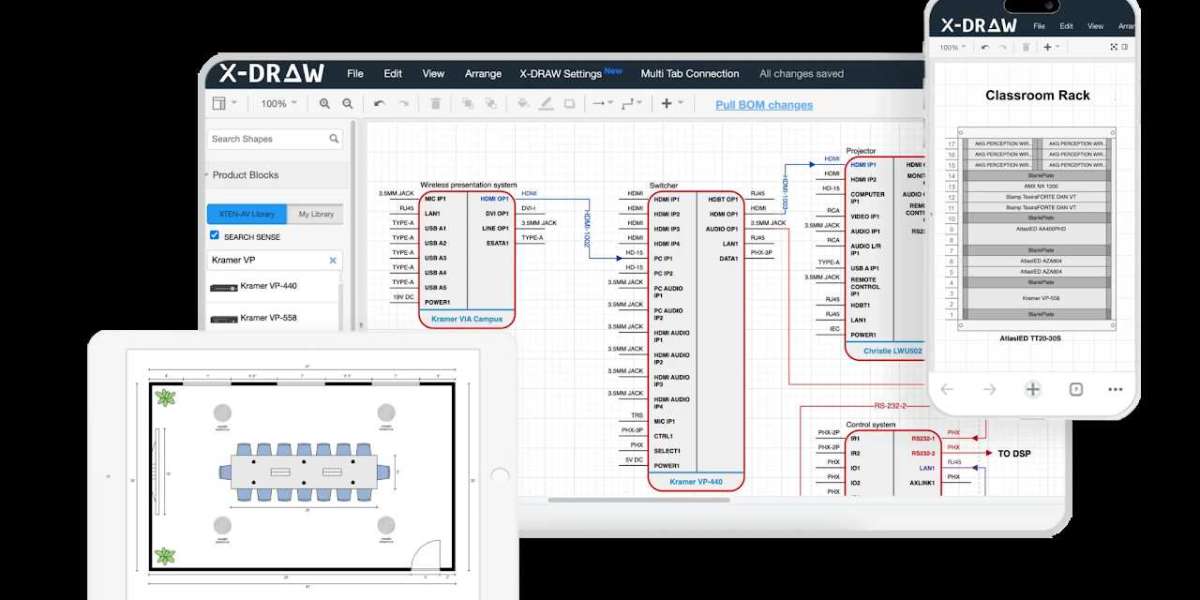In today’s rapidly evolving AV industry, having the right tools is only half the battle. Equally important is ensuring that your team can use those tools efficiently. Audio visual design Software has become essential for planning, documenting, and executing AV projects, but without proper training, even the most powerful AV design software may go underutilized. Efficient use of these platforms not only improves productivity but also reduces errors, saves time, and enhances collaboration across projects.
Training your team to use AV design software effectively requires a structured approach, clear goals, and ongoing support. This blog explores strategies and best practices for maximizing your team’s proficiency with AV design tools.
Step 1: Assess Current Skill Levels
Before implementing a training program, it is important to understand your team’s existing knowledge and experience with AV design software. Some team members may be familiar with basic CAD tools, while others may have no prior experience.
XTEN-AV provides an intuitive interface and built in tutorials that make it easier for new users to get started. However, assessing skill levels allows you to tailor training programs to meet individual needs. Surveys, interviews, and practical exercises can help identify areas where additional support is needed.
Step 2: Define Training Objectives
Clear objectives are essential for effective training. Decide what your team should achieve by the end of the program. Objectives may include mastering basic design tools, learning advanced features such as automated cable management, or understanding AI assisted design recommendations.
For example, your training goal might be to ensure that every team member can create a complete rack layout, generate wiring diagrams, and simulate audio coverage using AV design software. Defining specific objectives keeps the training focused and measurable.
Step 3: Use Structured Training Programs
Structured training programs provide a step by step approach to learning. Many AV design software platforms, including XTEN-AV, offer built in training modules that cover everything from basic navigation to advanced design techniques.
A structured program can include video tutorials, hands on exercises, and guided projects. By progressing from simple tasks to complex workflows, team members build confidence and competence. Structured training also ensures that everyone receives consistent instruction, reducing knowledge gaps across the team.
Step 4: Hands On Practice with Real Projects
Practical experience is key to mastering AV design software. Hands on practice allows team members to apply what they have learned in real world scenarios. This reinforces learning and builds problem solving skills.
XTEN-AV allows teams to work on live projects or simulated environments. By practicing on actual layouts, racks, or audio zones, team members gain familiarity with tools such as drag and drop equipment placement, automated cable routing, and AI assisted recommendations. Hands on exercises also help identify common mistakes and teach users how to avoid them.
Step 5: Encourage Collaboration and Peer Learning
Collaboration is a vital component of training. AV projects often involve multiple team members working together on different aspects of a system. Training sessions should include opportunities for group work and knowledge sharing.
XTEN-AV supports real time collaboration, enabling team members to work on the same design simultaneously. Encouraging peer learning allows experienced users to mentor newer team members, fostering a culture of shared knowledge and continuous improvement.
Step 6: Provide Access to Comprehensive Resources
Even after formal training, team members may need ongoing support. Providing access to comprehensive resources such as user manuals, FAQs, video tutorials, and knowledge bases ensures that users can quickly find answers to questions as they arise.
XTEN-AV includes a wide range of resources, including equipment libraries, online tutorials, and support documentation. Making these resources readily available helps team members resolve issues independently and continue improving their skills.
Step 7: Integrate Training into Daily Workflows
Learning is most effective when it is applied regularly. Encourage your team to integrate AV design software into their daily workflows. Assign small projects, design exercises, or review tasks that require the use of the software.
Regular use reinforces learning and helps users discover new features and efficiencies. XTEN-AV’s intuitive interface and automation tools make it easier for team members to incorporate software usage into everyday project tasks, from designing racks to mapping audio zones.
Step 8: Provide Feedback and Performance Metrics
Feedback is essential for continuous improvement. Regularly review your team’s work and provide constructive feedback on design accuracy, efficiency, and use of software features.
Performance metrics such as project completion time, error rates, and utilization of advanced tools can help identify areas for improvement. XTEN-AV allows managers to track progress and assess how effectively team members are using features like automated documentation, AI recommendations, and collaborative workflows.
Step 9: Encourage Advanced Learning and Continuous Development
Once your team is comfortable with basic functions, encourage them to explore advanced features. AI assisted design, real time simulation, and cloud based collaboration can significantly improve project outcomes.
XTEN-AV provides tools that allow users to experiment with AI recommendations, optimize audio and video layouts, and streamline complex system designs. Continuous learning ensures that your team remains up to date with new technologies and best practices in the AV industry.
Step 10: Foster a Culture of Knowledge Sharing
Finally, fostering a culture of knowledge sharing helps maintain long term efficiency. Encourage team members to document tips, tricks, and workflows that they discover while using AV design software. Share insights during team meetings, workshops, or online collaboration platforms.
A culture of shared learning ensures that best practices are consistently applied and reduces dependency on individual experts. It also makes onboarding new team members faster and more effective.
Benefits of Efficient AV Design Software Training
Proper training in AV design software provides numerous benefits. Teams work faster, reduce errors, and produce higher quality designs. Collaboration improves through shared understanding and consistent use of software features. AI assisted tools, cloud based workflows, and automated documentation are leveraged fully, maximizing return on investment in the software.
For organizations, efficient training translates to lower project costs, shorter design cycles, and increased client satisfaction. It also enhances employee confidence and engagement by giving team members the skills they need to excel.
XTEN-AV Leading the Way
XTEN-AV combines powerful AV design capabilities with user friendly interfaces, built in tutorials, and advanced AI assistance. Its cloud based collaboration, real time simulation, and automated documentation features make it an ideal platform for training teams efficiently.
By following a structured training approach with XTEN-AV, organizations can ensure that their teams are skilled, confident, and capable of leveraging the full potential of AV design software.
Conclusion
Training your team to use AV design software efficiently is essential for modern AV projects. Assessing skills, defining objectives, using structured programs, and providing hands on practice ensures that team members gain proficiency quickly. Continuous support, collaboration, feedback, and advanced learning opportunities further enhance efficiency and effectiveness.
With a platform like XTEN-AV, teams can learn faster, design smarter, and deliver projects with accuracy and confidence. Investing in proper training ensures that your AV design software becomes a true productivity tool rather than just another software application.
Read more: https://inspirejournal.xyz/common-mistakes-to-avoid-when-using-av-design-software/








